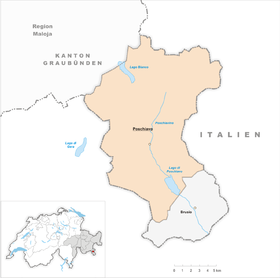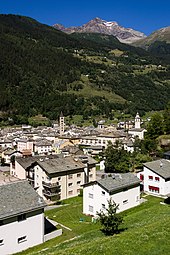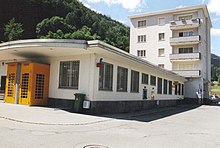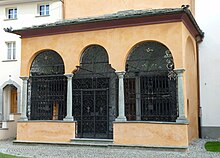Poschiavo
| Poschiavo | |
|---|---|
| State : |
|
| Canton : |
|
| Region : | Bernina |
| BFS no. : | 3561 |
| Postal code : | 7742 Poschiavo 7710 Ospizio Bernina 7710 Alp Grüm 7741 San Carlo 7745 Li Curt 7746 Le Prese |
| UN / LOCODE : | CH OBA (Ospizio Bernina) |
| Coordinates : | 801 614 / 133 766 |
| Height : | 1014 m above sea level M. |
| Height range : | 961–3899 m above sea level M. |
| Area : | 191.01 km² |
| Residents: | 3516 (December 31, 2018) |
| Population density : | 18 inhabitants per km² |
| Website: | www.poschiavo.ch |
|
The palazzi in January from the south |
|
| Location of the municipality | |
Poschiavo , in the Lombard local dialect Pus'ciav [pʊʃˈtɕɑːf] ( German / Rhaeto-Romanic Puschlav ), is a municipality in the southern canton of Graubünden , Switzerland . Together with the neighboring municipality of Brusio , Poschiavo forms the Puschlav valley ( Val Poschiavo in Italian ) and the Bernina region .
coat of arms
Blazon : In red two crossed silver keys connected by a silver chain .
It is a talking coat of arms ; for the actual meaning of place names see below .
geography

Poschiavo is around 15 kilometers south of the Bernina Pass , which connects the Engadine with the Valtellina . The municipal area includes the upper Poschiavo including side valleys and extends from the watershed in the north of the valley, which is formed by the Bernina group and the Forcola di Livigno , to the southern end of the Lago di Poschiavo (German: Puschlaversee ) at 962 m . The highest point of the territory bounded by mountain ridges in the west and east is the middle summit of Piz Palü at 3901 m .
The permanent settlements are mostly on or near the valley road and are divided into three groups ( squadri ):
- Squadra del Borgo, consisting of the main town ( borgo, Poschiavo in the narrower sense) and the village of Cologna;
- Squadra di Aino, to the north, consisting of the village of San Carlo and the hamlets of Somaino, Angeli Custodi, Percosta and Permunt;
-
Squadra di Basso , located south, consisting of
- Sant'Antonio with Campiglione, Li Curt and La Rasiga,
- Prada with Annunziata,
- Le Prese with Cantone, Pagnoncini and part of Miralago .
In addition, the municipality includes a large number of mountain pastures and alpine settlements .
The fourth largest municipality in the canton in terms of area is one of the most densely wooded in Switzerland. In 1997, 19.8% of the municipal area was used for agriculture, the forest took 32.1%, the settlements 1.8%. 46.2% were considered unproductive.
Neighboring municipalities are Pontresina and Brusio and the municipalities of Livigno , Valdidentro , Grosio , Grosotto , Chiuro and Lanzada, which are part of the Italian province of Sondrio .
climate
The annual mean temperature is 7.2 ° C, with the coldest monthly temperatures in January at −1.8 ° C and the warmest monthly mean temperatures in July at 16.4 ° C. On average, around 138 frost days and 38 ice days are to be expected here. There are around 19 summer days on average, while an average of 0.6 hot days , ie every one to two years, are recorded. The MeteoSwiss weather station is located at an altitude of 1078 m above sea level. M.
| Poschiavo, 1981-2010 | ||||||||||||||||||||||||||||||||||||||||||||||||
|---|---|---|---|---|---|---|---|---|---|---|---|---|---|---|---|---|---|---|---|---|---|---|---|---|---|---|---|---|---|---|---|---|---|---|---|---|---|---|---|---|---|---|---|---|---|---|---|---|
| Climate diagram | ||||||||||||||||||||||||||||||||||||||||||||||||
| ||||||||||||||||||||||||||||||||||||||||||||||||
|
Average monthly temperatures and precipitation for Poschiavo, 1981–2010
Source:
|
||||||||||||||||||||||||||||||||||||||||||||||||||||||||||||||||||||||||||||||||||||||||||||||||||||||||||||||||||||||||||||||||||||||||||||||||||||||||||||||||||||||||||||||||||||
The June heat record in Poschiavo was measured on June 27, 2019 at 34.3 ° C.
history
The significance of the finds made in the valley from Roman times has not yet been conclusively clarified. The early medieval conquest of the Valtellina is certain . The place Postclave and its baptistery , probably the later Collegiate Church of San Vittore, are mentioned in a document in 824. The Poschiavo was increasingly populated in the 11th century. The churches of San Pietro near Poschiavo and San Romerio above Lake Poschiavo date from that time .
In the 13th century Poschiavo appeared as a feudal property of the Chur bishop . After changing authorities, the valley came under Milanese rule in 1350 , from which it was forcibly liberated in 1406. The now always occurs as a unit Cumün (valley community, including Brusio) sought refuge with the bishop and joined the on September 29, 1408 Gotteshausbund at. With the purchase of the episcopal rights in 1494, full independence as a high court within the church association was achieved.
The Protestant community was founded in 1547 by refugees from Italy. In the following decades, both denominations used the collegiate church until the Protestants were able to build their own church in the wake of the Bündner turmoil , the Valtellina murder of 1620, the escape in 1623 and the arbitration decision of the Three Leagues in 1642. The Poschiavo Catholics were subordinate to the Diocese of Como until 1870, although politically the valley belonged to the Church of God and later to Graubünden.
In 1547 Dolfino Landolfi founded the first printing company in Graubünden in Poschiavo. In 1549 he brought out the first important printed works, including the statutes of the Valtellina, the first Italian-language evangelical catechism by Pietro Paolo Vergerio and the papal list of forbidden books . In 1620 a number of Landolfi's printing works were destroyed, but the Landolfi printing works continued with interruptions until 1720.
After the turbulent phase of the Grisons turmoil in the Thirty Years' War , Poschiavo took a rather calm development, which was mainly based on pass traffic and agriculture. From the 17th to the 19th century, many Poschiavo people emigrated, preferably to Spain, Portugal and France, some also to America or Australia, in order to run coffee houses and confectioners there.
The current division with independent communities Poschiavo and Brusio has existed since 1851. With the construction of the Bernina Railway and power stations in 1904–1912, the valley was freed from its seclusion. The population stabilized, and tourism was able to develop as an important industry.
In the summer of 1987, large parts of the village were devastated by a severe storm. The major damage was repaired in years of work.
Place name
The place name Poschiavo goes back to the Latin post clāvem and literally means “behind the key”, with clāvis (to claudere “to close, lock”) here in the special meaning “bolt, talenge”. What is meant is the narrowing that closes the Puschlav against the Valtellina.
The older view that the name goes back to post lacum (German: “behind the lake”) is not possible in phonetic history. Rejected as unnecessary and hypothetically is the current name of research, moreover, an also elderly, in connection with the linguistically related place names Chiavenna voiced suggestion that the name on an unspecified known vorlateinische substrate language due, using as a basis a " alluvial fan " significant Appellativum * clava had to accept .
population
development
| Population development | |||||||||||||||
|---|---|---|---|---|---|---|---|---|---|---|---|---|---|---|---|
| year | 1850 | 1860 | 1870 | 1900 | 1910 | 1950 | 1980 | 1990 | 2000 | 2010 | 2017 | ||||
| Residents | 2888 | 2741 | 2890 | 3102 | 3676 | 4034 | 3294 | 3178 | 3225 | 3506 | 3516 | ||||
After the first large wave of emigrants between 1850 and 1860, the population grew continuously until 1950 (1850–1950: +39.68%). The increase was particularly large between 1900 and 1910, when the Bernina Railway was completed. A second wave of emigration between 1950 and 1990 led to industrial centers and tourist resorts (1950–1990: −21.22%). Since then the population has been growing again (1990–2005: +9.72%).
languages
The colloquial language is the Alpine Lombard dialect Pus'ciavin . In 1900 it was spoken by 2992 (= 96.45%) of the population. Today the proportion of Italian speakers has leveled off at around 90%, as the following table shows:
| Languages in Poschiavo | ||||||
| languages | 1980 census | 1990 census | 2000 census | |||
| number | proportion of | number | proportion of | number | proportion of | |
| Italian | 3028 | 91.92% | 2858 | 89.93% | 2917 | 90.45% |
| German | 208 | 6.31% | 255 | 8.02% | 255 | 7.91% |
| Romansh | 24 | 0.73% | 22nd | 0.69% | 14th | 0.43% |
| Residents | 3294 | 100% | 3178 | 100% | 3225 | 100% |
The only official language of the municipality is Italian.
Origin and nationality
Of the 3487 residents at the end of 2005, 3246 (= 93.09%) were Swiss citizens.
economy
Infrastructure and sectors
Poschiavo forms the center of the valley as the location of the secondary school, trade school and hospital. The economic structure is characterized by a large number of small craft, trade and service companies that cover practically all areas of daily life. The Rhaetian Railway and Repower should be mentioned as major employers .
276 people were employed in agriculture, 471 in manufacturing and 1,049 in the service sector (as of 2000–01).
traffic
The Berninastrasse runs through the municipal area along its entire length. About 2 km below the pass, the road, which is only passable in summer, branches off over the Forcola into the duty-free Italian area of Livigno.
For the Bernina Railway, which opened in 1908, Poschiavo means the most important train station south of the pass. The direct current locomotives of the Rhaetian Railway are serviced in the depot with the attached workshop. The base of the railway service with catenary service looks after the entire 60 km long railway line. The station building was rebuilt in 1962, and the depot was expanded from 1969 to 1972. The station also has a brisk freight traffic. Among other things, the local supermarket of a large retail chain is supplied with goods by rail. The well-known stations Ospizio Bernina and Alp Grüm are also located in the municipality , plus a total of 6 other stations and stops.
Attractions
The Borgo of Poschiavo has a closed, urban-looking townscape with stone-slab-roofed houses from the 16th to 19th centuries. After a flood on July 18, 1987 caused severe damage in the village center, the buildings were carefully restored. Poschiavo has a townscape of national importance .
Around the central Plazza da Cumün are grouped:
- the late Gothic collegiate church of San Vittore with its Romanesque tower,
- the old women's monastery (Vecchio Monastero) with the baroque chapel Santa Maria Presentata,
- the Casa Tomé,
- the oratory Sant'Anna with ossuary,
- the town hall with a former defense tower .
Not far away is the reformed church of Santa Trinità from 1649.
- The Palazzo De Bassus-Mengotti on the other side of the Poschiavino river was set up as a valley museum.
- On the southern edge of the village, some palazzi such as the Devon House, which were built by wealthy returnees , form the "Spaniolenviertel" .
- Even further south, formerly in an open field about 500 meters outside the village, the church of Santa Maria Assunta was built between 1692 and 1711 , which is considered one of the most beautiful baroque churches in Switzerland.
The parish church of the same name, built between 1613 and 1624, is located at the upper entrance to the village of San Carlo . The later added Passion Chapel contains frescoes by an unknown Lombard master from the middle of the 17th century. Together with the rectory, under whose archway the Berninastrasse passes, the church forms a picturesque group of buildings with a sawmill, mill, forge and wash house.
Also in the settlements of the Squadra di Basso you can find a number of well-preserved houses from the 17th and 18th centuries, with wall paintings, window bars and the typical stone roofs. The village of Prada and the small hamlet of Cantone have particularly closed sites . Examples of genuine small settlements are La Dota, Pisciadel and Splüga .
The chapel of San Pietro, the chapel of Santi Sebastiano e Sinforosa in Selva, the Museo d'arte Casa Console, the Casa Fanconi, the Casa Gervasi, the Casa Matossi-Lendi, the Casa Olgiati, the Fabbrica Ragazzi, the hotel are also significant in terms of art history Albrici, with paintings Dodici sibille and Dama triste by the painter Fra Galgario , the Landolfi houses, the old Protestant school, the reception building of the Bernina Railway, the Bernina Ospizio train station , the Palü headquarters, the Albergo Bagni in Le Prese, the Raselli-Kalt house (2002) in Li Curt ., The Mulino di Aino (sawmill and forge) in Privilasco and the Palazzo Dorizzi (Crameri) in Lino.
Hikes lead to the Maiensässen and the Alps. The Maiensäss Selva has small churches of both denominations on two neighboring hills, including the chapel of Santi Sebastiano e Sinforosa , and a cold store. Since 1825, on the first beautiful Sunday in May, Protestant families have been walking to their small chapel on Selva. After the service, polenta is prepared from buckwheat flour in a huge kettle .
Culture
- Historical community archive (Casa Torre) in Via da Mez
- Museo valligiano poschiavino ( Val Poschiavo Valley Museum ) in Via da Spultri 270
- Società storica Val Poschiavo
- Archivio fotografico Luigi Gisep
Personalities
photos
literature
- Arno Lanfranchi: Poschiavo (municipality). In: Historical Lexicon of Switzerland . July 30, 2015 .
- Simona Martinoli u. a .: Guida d'arte della Svizzera italiana. Edited by the Society for Swiss Art History . Edizioni Casagrande, Bellinzona 2007, ISBN 978-88-7713-482-0 , pp. 547-556.
- Daniele Papacella (Ed.): Il Borgo di Poschiavo. Un paese si reinventa: storia, società e architettura tra Ottocento e Novecento. Società Storica Val Poschiavo, Tipografia Menghini, Poschiavo 2009.
- Erwin Poeschel : The art monuments of the canton of Graubünden. Volume VI: The Italian Grisons valleys Puschlav, Misox and Calanca (= Swiss art monuments. Volume 17). Edited by the Society for Swiss Art History GSK. Bern 1945, ISBN 978-3-906131-55-9 .
- Tomaso Semadeni: Poschiavo. In: Historisch-Biographisches Lexikon der Schweiz , Volume 5: Pictet - Resti. Attinger, Neuchâtel 1921, pp. 351–353 ( digitized version ).
Web links
- Poschiavo on the ETHorama platform
- Official website of the municipality of Poschiavo (Italian)
- Cristina Giulia Codega, Un'insolita procedura. Il caso delle “Meneghine”, streghe poschiavine inviate al giudizio dell'Inquisizione di Como nel 1709.
- Federal inventory ISOS: Poschiavo
- Federal Inventory ISOS: San Carlo
- Federal inventory ISOS: Cantone
- Federal inventory ISOS: Prada
- Poschiavo on elexikon.ch
- The ceramics collection of the Museo Poschiavino and the Casa Tomé in CERAMICA CH - Swiss National Ceramic Inventory
Individual evidence
- ↑ Permanent and non-permanent resident population by year, canton, district, municipality, population type and gender (permanent resident population). In: bfs. admin.ch . Federal Statistical Office (FSO), August 31, 2019, accessed on December 22, 2019 .
- ↑ a b Lexicon of Swiss municipality names . Edited by the Center de Dialectologie at the University of Neuchâtel under the direction of Andres Kristol. Huber, Frauenfeld and Payot, Lausanne 2005, p. 713 f.
- ↑ Climate table. In: meteoschweiz.admin.ch. meteoschweiz, accessed on April 12, 2018 .
- ↑ The downside of the heat wave - swimming accidents, high ozone levels and the risk of forest fires. In: srf.ch . June 28, 2019, accessed June 29, 2019 .
- ^ Adolf Collenberg: Landolfi, Dolfino. In: Historical Lexicon of Switzerland . November 14, 2007 .
- ^ Arno Lanfranchi: Poschiavo (municipality). In: Historical Lexicon of Switzerland . July 30, 2015 .
- ^ Arno Lanfranchi: Poschiavo (municipality). In: Historical Lexicon of Switzerland . July 30, 2015 .
- ↑ a b c d e f g h i j k l m Simona Martinoli u. a .: Guida d'arte della Svizzera italiana. Bellinzona 2007, ISBN 978-88-7713-482-0 , pp. 547-553.
- ↑ Collegiate Church of San Vittore on graubuendenkultur.ch
- ↑ Women's monastery (Vecchio Monastero) on graubuendenkultur.ch
- ↑ Casa Tomé on graubuendenkultur.ch
- ↑ Oratorio Sant'Anna on graubuendenkultur.ch
- ↑ Town hall with a former defense tower on graubuendenkultur.ch
- ^ Reformed Church of Santa Trinità on graubuendenkultur.ch
- ↑ Museo poschiavino
- ↑ Palazzo De Bassus-Mengotti on graubuendenkultur.ch
- ↑ Palazzi on graubuendenkultur.ch
- ^ Church of Santa Maria Assunta on graubuendenkultur.ch
- ↑ Chapel of San Pietro on graubuendenkultur.ch
- ↑ Chapel of Santi Sebastiano e Sinforosa on graubuendenkultur.ch
- ^ Museo d'arte Casa Console
- ↑ Casa Fanconi on graubuendenkultur.ch
- ↑ Casa Gervasi on graubuendenkultur.ch
- ↑ Casa Matossi-Lendi on graubuendenkultur.ch
- ↑ Casa Olgiati on graubuendenkultur.ch
- ↑ Fabbrica Ragazzi on graubuendenkultur.ch
- ↑ Hotel Albrici on graubuendenkultur.ch
- ↑ Mariusz Karpowicz: Il tesoro di Poschiavo un quadro di Fra Galgario (Italian) on e-periodica.ch/digbib (accessed on March 26, 2017).
- ↑ Landolfi houses on graubuendenkultur.ch
- ↑ Old Protestant school on graubuendenkultur.ch
- ↑ Admission building of the Bernina Railway on graubuendenkultur.ch
- ↑ Bernina Ospizio train station on graubuendenkultur.ch
- ↑ Headquarters Palü on graubuendenkultur.ch
- ↑ Albergo Bagni Le Prese on graubuendenkultur.ch
- ^ Haus Raselli-Kalt on graubuendenkultur.ch
- ^ Società storica Val Poschiavo
- ↑ Archivio fotografico Luigi Gisep
















